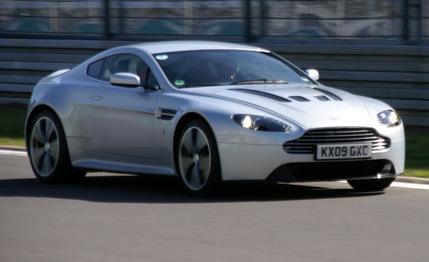
 First Drive Review
First Drive Review


The 2010 Aston Martin V-12 Vantage is the perfect example of what springs from the deepest urge felt by enthusiastic automotive engineers: Stuff the biggest engine into the smallest possible body. Aston Martin CEO Ulrich Bez, by all accounts, is truly an enthusiastic automotive engineer.
Proof? At Porsche, he spearheaded the 989 project, a four-door that still looks so right the company won't let the prototypes come near the Panamera. Moving to BMW, Bez created the cultish Z1 roadster. He finally took the ultimate position at Aston Martin in 2000.
A Hot Rod for the Old Country
And so, Bez could not leave his smallest child, the stunningly beautiful, compact, and neatly packaged V-8 Vantage, alone. He wondered whether the 5.9-liter V-12 that powers the elegant DB9 and the more aggressive DBS would fit into the car’s engine bay. It was nearly a given, since the V-8 Vantage is based on the VH platform that also forms the foundation of the DB9 and DBS, but the smaller car was never really designed to hold the massive, Cologne-built V-12 engine.
You can see now that the transplant was successful, albeit after extensively revising the V-8 Vantage’s front structure. Nevertheless, Aston Martin managed to achieve a nearly perfect 51/49-percent front-to-rear weight balance. The extra mass of the engine, an additional 200 or so pounds, is partly offset by carbon-ceramic brakes and lighter wheels, as well as lighter seats and rear quarter-panels. The total weight of the V-12 Vantage, at around 3700 pounds, is only about 100 more pounds than the V-8 Vantage.
This extra weight is effortlessly neutralized by the V-12's 510 hp and 420 lb-ft of torque, available at 6500 rpm and 5750 rpm, respectively. The engine is tuned the same as in the larger DBS and thus catapults this relatively tiny coupe into a completely different league. We pedaled a DBS to 60 mph in 4.3 seconds—a time identical to that posted by the V-8 Vantage. Aston claims the sprint from 0 to 62 mph takes 4.2 seconds in the V-12 Vantage, so we expect it would become the fastest Aston ever were we to test it—well, the fastest until the One-77 goes on sale. Top speed is now 190 mph, up from 180 for the V-8. However, what really makes the difference is the incredible agility and responsiveness of the engine.
The V-12 Vantage charges forward with brutal force inconceivable in the V-8, or even in the DB9 and DBS. Those two bigger and heavier models dilute the raw punch provided by this powerhouse. Too, the combination of the Vantage’s lower seating position, more compact dimensions, firmer suspension, and louder exhaust adds a massive dose of excitement. Unlike other Astons, the V-12 Vantage gives you a comfortable power margin to take on pretty much any Porsche 911, and have the occasional BMW M3 as a snack.
Torque is plentiful across the rev band, and the engine’s soundtrack is pure music. The power is transmitted to the rear wheels by means of a smooth-shifting six-speed manual transmission, still the best solution for a sports car targeting avid enthusiasts. The automated manual transmission available in the other Aston Martin models isn't even offered here.
The Driver’s Aston
We applaud that decision, just as we congratulate Aston Martin for not offering a topless version, which would similarly dilute the purposeful character of this car. Unfortunately, the pedal layout is far from ideally spaced to facilitate heel-and-toe shifting and is a disappointing glitch in an otherwise perfect driver's car. We also had a hard time finding a good seating position.
The chassis is firmed up enough to have a blast on the track, but it won't ruin your back on the way there. Carbon-ceramic brakes, which are standard, keep the car fade-free even under extremely challenging track conditions, something that can't be said of the cast-iron brakes used in the V-8 Vantage. The stability-control system is so unobtrusive that you'll likely keep it engaged most of the time. If you elect to turn it off, beware of robust power-on oversteer.
Messing with a Nearly Perfect Design
The V-12 Vantage retains the handsome body of its V-8–engined counterpart, but it looks more brutal ,with extra air intakes on the hood, a front splitter, a rear diffuser, and new side sills. Carbon fiber is used liberally, validating this Aston's sporting aspirations but adding a bit of visual fuss. And the 19-inch wheels clearly lack the finesse exhibited elsewhere on the car.
Inside, the Aston offers one of the most beautiful and futuristic cockpits on the market. The solid metal and glass key and a glass ashtray have become brand trademarks. The V-12 Vantage adds Alcantara and carbon-fiber elements, which look purposeful but are just as decorative as those in certain Mercedes-AMG and Porsche offerings.
The Aston Martin V-12 Vantage, in Germany, elevates the price from €115,150 for the V-8 Vantage to €169,500, or about the same as the DB9. (Converted to greenbacks, it costs $247,000.) Only 1000 will be made, but we have no doubt that this Aston Martin, the most satisfactory currently on the road and perhaps ever, will hold its ground well against competitors such as the Porsche 911 GT2 and GT3 and the Lamborghini Gallardo. Well, in Europe, that is, since we can’t get it in the States. Pity.